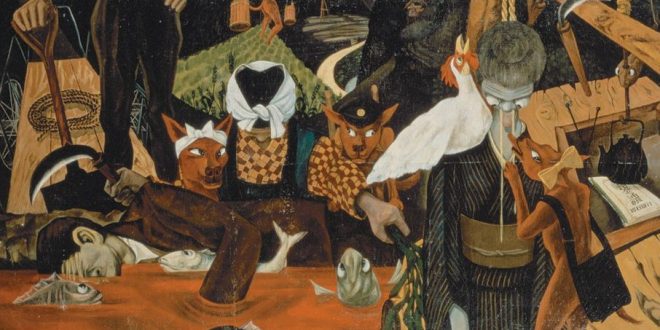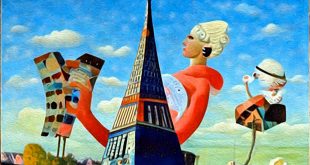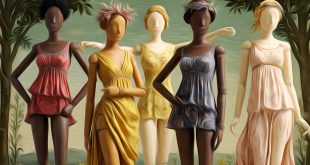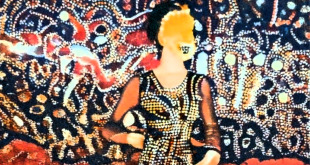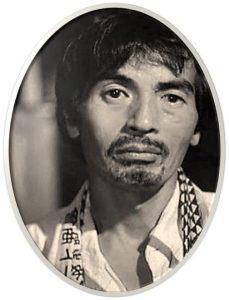 The influences of Fukuzawa and Bosch in the surrealism of Kikuji Yamashita
The influences of Fukuzawa and Bosch in the surrealism of Kikuji Yamashita
Although he painted hundreds of canvases, Kikuji Yamashita avoided seeking commercial success, surviving financially as an artist on his wife’s earnings as a beautician. In 1953 he joined with many young artists to form the Young Artists’ Alliance art cooperative, which for three years held exhibitions and published a magazine called Art of Today. In 1976, Kikuji Yamashita was the subject of a documentary film by Shinkichi. At the Center Pompidou in Paris, before his death some of his paintings were included in the major international exhibition Avant-Garde Arts of Japan 1910-1970. In 2010, Linda Hoaglund featured his paintings in a documentary film.
In his early life, Yamashita studied painting with the famous Japanese surrealist Ichirō Fukuzawa, who introduced him to the work of Max Ernst, Salvador Dalí, and Hieronymus Bosch. In 1962 he held his first solo exhibition. Kikuji Yamashita was born in 1919 in Miyoshi, Japan’s Tokushima Prefecture, where the Shikoku Mountains feature steep slopes prone to landslides and rockfalls. Graduating from Takamatsu Crafts High School in 1938, he moved to Tokyo, where he began studying with the Japanese surrealist painter Ichirō Fukuzawa, becoming acquainted with the work of Max Ernst and Hieronymus Bosch. In 1970 he wrote an essay relating to his war years, including the guilt he felt for his actions at the time.
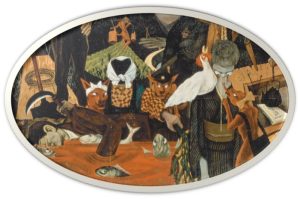 In 1939, Kikuji Yamashita joined the Japanese army and fought in China. Having survived the war and living with memories of his wartime experience, he generated a personal opposition to the war, which was reflected in his art. In the late 1960s he was still painting surrealist paintings that criticized the presence of US military bases on Japanese soil. In 1974 he founded an artistic collective called Ichirō Fukuzawa, with which he remained until 1984, leaving with health problems. Numerous galleries and museums, such as the National Museum of Contemporary Art of Korea, have presented his work. In 1952, to galvanize farmers into forming a militant resistance movement against a dam, Kikuji Yamashita and other artists traveled to the village of Ogōchi, where he produced surrealist oil paintings relating to the struggling lives of farmers. During this period, he painted The Tale of Akebono Village, a painting depicting an activist lying in a pool of blood and a hanging grandmother, along with the villagers depicted as animals. He was a bird lover and even kept owls as pets in his home, where he died in November 1986.
In 1939, Kikuji Yamashita joined the Japanese army and fought in China. Having survived the war and living with memories of his wartime experience, he generated a personal opposition to the war, which was reflected in his art. In the late 1960s he was still painting surrealist paintings that criticized the presence of US military bases on Japanese soil. In 1974 he founded an artistic collective called Ichirō Fukuzawa, with which he remained until 1984, leaving with health problems. Numerous galleries and museums, such as the National Museum of Contemporary Art of Korea, have presented his work. In 1952, to galvanize farmers into forming a militant resistance movement against a dam, Kikuji Yamashita and other artists traveled to the village of Ogōchi, where he produced surrealist oil paintings relating to the struggling lives of farmers. During this period, he painted The Tale of Akebono Village, a painting depicting an activist lying in a pool of blood and a hanging grandmother, along with the villagers depicted as animals. He was a bird lover and even kept owls as pets in his home, where he died in November 1986.
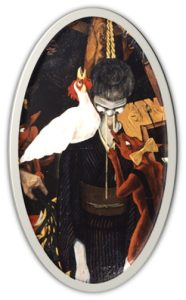 After the war, Yamashita participated in the formation of the Japan Art Association and co-founded the Avant-Garde Art Society. However, he eventually broke with the rigid ideological directives of the Communist Party and produced large-scale surrealist oil paintings, including his most famous work, “The Tale of Akebono Village.” His unique blend of surrealism and social criticism continues to resonate in the art world. If you would like to find out more about Kikuji Yamashita, you can find more information at the Tate.
After the war, Yamashita participated in the formation of the Japan Art Association and co-founded the Avant-Garde Art Society. However, he eventually broke with the rigid ideological directives of the Communist Party and produced large-scale surrealist oil paintings, including his most famous work, “The Tale of Akebono Village.” His unique blend of surrealism and social criticism continues to resonate in the art world. If you would like to find out more about Kikuji Yamashita, you can find more information at the Tate.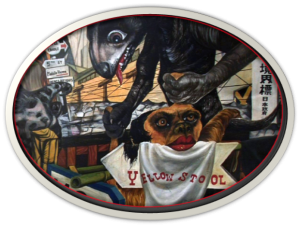
The “History of Akebono Village” is one of his most famous works. Created in 1950, this surrealist oil painting combines dreamlike imagery with social commentary. In the painting, Kikuji Yamashita depicts a fantastic village where bizarre and symbolic scenes take place. The elements that create an otherworldly atmosphere in the vividly colored canvas are distorted buildings and strange creatures. The surreal elements serve as metaphors for social issues. In the painting rich in symbolism, twisted trees and enigmatic figures invite interpretation. Yet, the artist intentionally left room for ambiguity, allowing viewers to interact with the artwork on a personal level. You can see this painting at The National Museum of Modern Art in Tokyo. If you want to find an online reproduction of the painting, I recommend searching on art gallery websites, art sales platforms or search engines. Remember to check the authenticity and quality of the reproduction before making a purchase.
 Meeting Benches World art in all forms
Meeting Benches World art in all forms
